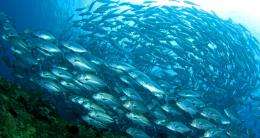Ambient marine noise as an eco-friendly way to monitor ocean physics

(PhysOrg.com) -- The ocean is a noisy place. Raindrops smack the surface, waves break, whales sing, and ship engines roar. These can all coalesce into a cacophony of underwater noise that, to many, would just sound like a mess. Making sense out of this oceanic garble comes a new study which looks at the ways ambient underwater noise can help researchers keep an ear on ocean physics, something potentially helpful for climate science and wildlife alike.
“Our ability to quantify and predict climate change, control transport of oil and other pollutants in water, forecast generation and motion of hurricanes is limited by scarcity of subsurface measurements of temperature, currents, and other physical parameters in the ocean,” said Oleg Godin, study author and researcher with the University of Colorado at Boulder and NOAA’s Cooperative Institute for Research in Environmental Sciences (CIRES).
Using sound to understand ocean physics is nothing new. For years, scientists looked to sound to study its movement through water, the topography of the seabed, and changing sea temps. For example, sound travels faster or slower depending on the temperature and to a lesser extent salinity of the water, so understanding the speed by which sound moves through the water can offer clues to changes in sea temperature. Sea temperature affects weather, currents, and chemical processes in the ocean and is an important indicator of climate change.
Right now, satellites take measurements of sea surface temperature, but different methods are required to understand what lies beneath. “Away from the surface, remote sensing of the ocean requires acoustic techniques,” said Godin, also with NOAA’s Earth System Research Laboratory (ESRL).
But these projects often entail beaming loud sounds through the ocean from known locations and receiving those sounds on distant hydrophones, a technique that can be expensive and arguably harmful to marine life. The ocean’s natural noisiness can also prove troublesome in these experiments, much like trying to listen to one conversation in the middle of a busy restaurant.
Turns out that jumble of noise can still be scientifically valuable. Inspired by the way animals process a multitude of sounds to make sense of their environment, Godin and his colleagues Nikolay Zabotin with CIRES and Valery Goncharov with the Shirshov Oceanology Institute in Moscow, began thinking about listening to the ocean environment in a similar manner.
“Mammals and other vertebrates rely on daylight coming from the sky for vision and compare signals reaching their ears to locate sound sources,” said Godin. “We can use the noise scattered throughout the oceans as an acoustic version of daylight and compare noise received by different hydrophones to measure sound speed.”
To do this, they pulled data from the Billboard Array project, a 1998 to 1999 low-frequency sound propagation experiment run by the North Pacific Acoustic Laboratory off the coast of Point Sur, California. With about a year of sound data, Godin and his colleagues took the ocean’s ambient sound readings and tested whether they could cross-correlate the noise between the hydrophones.
Generally, knowing where a sound comes from is an important factor for determining its speed between point A and point B. So sound coming from a lot of unknown sources would seem to make ambient noise an unlikely data set. But Godin, Zabotin and Goncharov found a threshold where the sheer multitude of sources starts to make up for origins unknown.
“If you have one source and you know where it’s located, it’s easy to interpret measurements,” said Godin. “With ten sources that you don’t know where they are, things get difficult, but if you have a thousand sources of unknown origins, it begins to become feasible again to get good measurements.”
By looking at a set of hydrophones, Godin, Zabotin, and Goncharov could take a reading of a random sound arriving at one hydrophone and determine information about its speed by measuring how long it took for that sound to arrive at another underwater microphone. Given enough measurements taken in this way, confidence grows, and a picture of ocean physics begins to form.
This is the first time researchers have successfully put the theory of using ambient sound to monitor ocean physics into practice. Challenges of using this passive acoustic technique had included the motion of the hydrophones and water, changing sound sources of unknown origin, and the extraordinarily high level of accuracy needed for viable measurements of water temperature.
Now that Godin, Zabotin and Goncharov have figured out that ambient noise can reveal clues about ocean physics, they are working on perfecting the technique with the goal of making the method a standard tool for underwater acoustic observatories. Relying on ambient noise also has the benefit of being potentially more economical and easier to deploy in different regions of the ocean.
“Underwater sound has a huge and still mostly untapped potential for revealing the structure and dynamics of the ocean,” said Godin. “We hope that this potential will be finally brought to bear on critical problems of ocean stewardship and climate science.”
The study can be found in the current issue of Geophysical Research Letters.
Provided by University of Colorado at Boulder















